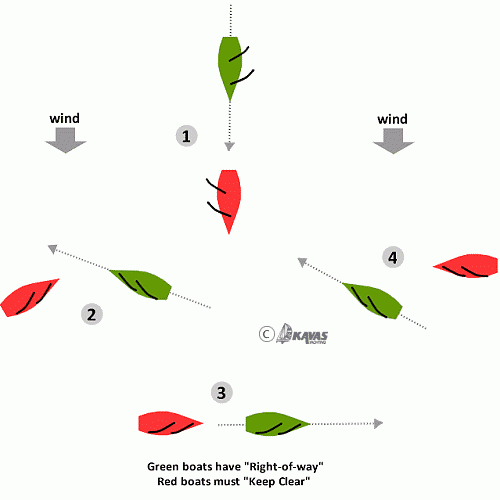Rules of the road
Importance of Rules in Sailing
Sailing, whether for leisure or competition, relies on a shared understanding of rules to maintain order and prevent accidents at sea. To ensure a smooth voyage, don't forget the importance of a brief 10-minute crew pre-briefing.
It sets the tone for a safe and enjoyable experience on the water.
Rules serve as the navigational compass that ensures a harmonious coexistence among vessels, fostering a culture of respect and responsibility on the water.
Introduction to Internationally Recognized Regulations
At the heart of maritime order lies a comprehensive set of internationally recognized regulations known as the COLREG, or the International Regulations for Preventing Collisions at Sea.
Established to provide a standardized framework for vessel navigation, the COLREG outline the responsibilities of sailors and specify the actions to be taken in various maritime scenarios.
From the navigation lights adorning vessels to the distinct sounds echoing across the waves, these regulations form the backbone of safe and efficient sailing practices worldwide.
Sailboat Navigation with Key COLREG for Safe Seamanship
These rules are essential for sailboat skippers to understand and apply to ensure safe navigation and to prevent collisions at sea.
The COLREGS, consist of 38 rules, making a detailed analysis impractical here.
Instead, we'll focus on the key rules, especially relevant to sailors, within the broader framework of these regulations.
Sailing Vessels [Rule 12]

- When both vessels have the wind on different sides (1, 2):
The one which has the wind on the port side (left side when facing forward) shall keep out of the way of the other. - When both vessels have the wind on the same side (3, 4):
The one which is to windward (upwind) shall keep out of the way of the one which is to leeward (downwind). - If a sailing vessel with the wind on the port side sees a sailing vessel to windward and cannot determine with certainty whether the other vessel has the wind on the port or starboard side, the former shall keep out of the way of the latter.
Narrow Channels
- When navigating in a narrow channel, sailboats should avoid impeding the safe passage of vessels that can only navigate safely in the channel.
Sailboats should stay as far to the outer limit of the channel as is safe and practical.
Traffic Separation Schemes
- Sailboats should avoid impeding the safe passage of power-driven vessels following the traffic lanes in a Traffic Separation Scheme (TSS).
If a sailboat needs to cross a traffic lane, it should do so at a right angle to the general direction of the traffic flow.
Responsibilities Between Vessels
- Sailboats are considered "vessels under sail" and generally have the right of way over power-driven vessels when under sail alone.
However, this "right" of way is not absolute, and sailboats should still take action to avoid collisions when it becomes apparent that the give-way vessel is not taking adequate measures.
Head-on Situation
- In a head-on situation where two sailboats are approaching each other, both should alter their course to port (left) so that they pass on the port side.
Action by Stand-on Vessel
- If a sailing vessel has the right of way (the stand-on vessel), it should maintain its course and speed, provided it is clear that the give-way vessel is taking sufficient measures to avoid a collision.
Overtaking
- When overtaking another sailing vessel, the overtaking sailboat should keep clear of the overtaken vessel.
The overtaken vessel has the right to sail its course, and the overtaking vessel should avoid impeding its progress.
Always use good seamanship, maintain a proper lookout, and take early and positive action to avoid potential dangers.
Special Considerations for Distinct Vessel Categories
The COLREG outline specific rules for the interaction between sailboats and other types of vessels, including those not under command, vessels restricted in their ability to maneuver, and vessels engaged in fishing.
Here's how sailboats should generally relate to these types of vessels:
- Vessel Not Under Command
A sailboat should give way to a vessel not under command. A vessel not under command is a vessel that, through some exceptional circumstance, is unable to maneuver as required by the COLREGs. Sailboats should take early and substantial action to keep clear of such vessels. - Vessel Restricted in Her Ability to Manoeuvre
Sailboats should give way to vessels that are restricted in their ability to maneuver. These are vessels that, due to their work or the nature of their operations, have limited maneuverability. Sailboats should avoid impeding the safe passage of such vessels. - Vessel Engaged in Fishing
Sailboats generally have the right of way over vessels engaged in fishing when the sailboat is under sail alone. However, this right of way is not absolute. If it becomes apparent that the fishing vessel is not able to give way, the sailboat should take action to avoid a collision. When a sailboat is under power, it is considered a power-driven vessel, and the standard COLREGs rules for power-driven vessels apply.
In all cases, the general principles of maintaining a proper lookout, navigating at a safe speed, and taking early and effective action to avoid collisions should be applied by sailboat skippers when encountering vessels not under command, vessels restricted in their ability to maneuver, and vessels engaged in fishing.
Conclusion
In the world of sailing, safety is paramount.
This guide concludes with a resounding encouragement for sailors to prioritize safety through unwavering adherence to rules.
Whether you're embarking on your first sail or are a seasoned mariner, embracing and practicing these rules ensures a secure and enriching experience for all who venture into the vast expanse of the open waters.
May your future voyages be filled with smooth sailing, guided by a deep understanding of the rules that unite sailors across the globe.
Fair winds and safe travels!

